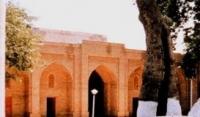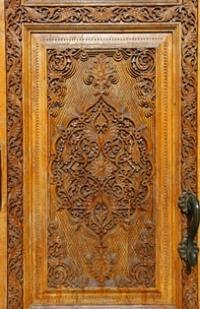You are here
Mahdum-i A’zam necropolis.



Cultural tours over ancient monuments of the Samarkand area.
“People usually feel funny, smile and laugh when I tell them
about my strong belief in the very existence of prehistoric
advanced technology and great civilizations of wilier races.
I just can't wait to see their faces at time the truth is revealed”
Toba Beta.
Photo tours in Samarkand and Bukhara.
Near Samarkand, in the village of Dagbit there is a necropolis connected with outstanding Sufi Said Ahmad Hodji Kasani ad-Dahbidi (1463 - 1464 – 1542 - 1543), known also as Mahdum-i A’zam (lord of the world).
He had been a head of Central Asian Sufi tariqah “naqshbandiyyah" from 1515 up to his death. He was a son of famous Khodja Djalal ad-Din Kasani and a disciple of Muhammad Qazi, murid of Khodja Akhrar.
At Mahdum-i A’zam, "naqshbandiyyah" managed to recover its spiritual and political influence, weakened by persecutions of Shaybani-khan against Khodja Akhrar and his family.
Khodja Ahmad's spiritual authority and ideas of "naqshbandiyyah" were recognized by new Shaybanid governors: Kuchkundja-khan (1510-1530), Abu-Sa’id-khan(1530 - 1533) and Ubaidullah-khan I (1533 - 1539).
Khodja Kasani became a major spiritual teacher of Ubaidullah-khan I,, what caused his patronage upon Sufism. The work of Mahdum-i A’zam “Tanbih ah-salatin (Treatise about edification to sultans)” was devoted to Ubaidullah-khan I.
While Muhammad al-Gazali defined three basic conditions of Sufi way: Ihvan - Brotherhood, Zaman - Epoch, Makan - Place, Mahdum-i A’zam added one more condition - Khan - Governor.
Naqshbandi sheikhs should actively communicate with sultans and edify them, in order “to shorten hands of evil and violence” and “to plant seeds of sheriat at courts of sultans”. Just in this case, the sultan can fulfill his mission, as a vicar of Allah on the earth.
The necropolis of Mahdum-i A’zam in Dagbit was constructed by the governor of Samarkand, Yalangtush-biy, known for construction on Registan. He related himself to "naqshsbandi" and had his pir, Khodja Hashim, the grandson of Mahdum-i A’zam and influential politician, playing an important role in enthronement of Astarkhanid Imam-Kuli-khan (1611 - 1642). Formation of the necropolis began in 1619 from khanaka, serving a residence of sheikh, visited by the people.
Dahma with tombs of Mahdum-i A’zam and his descendants was constructed synchronically. Originally, khanaka included a big hall for Sufi rituals, utility premises and a special room for ritual ablution.
Now, khanaka represents six-pillar twelve-dome structure with wooden aivan at the long side of the hall. On the eastern side there is a small structure – “small mosque”. In the yard of khanaka there is minaret, preserved at the height of 8 m.
To the north from khanaka is located dahma-sufa, built from the grey "Samarkand" marble and decorated with marble semi-pillars at the corners. The Koran verses in Arabian were ept in cartouche on the flat capital of southeastern semi-pillar. In special niches made of plates are installed seven steles and one gravestone, richly carved.
Beneath dahma, on the south there are nine carved marble gravestones, one of which belongs to Yalangtush-biy Bahadur. The fence around dahma was installed upon the order of Nadir Muhammad-divan-beghi, Bukhara dignitary of the XVII century.
Authority:
Alexey Arapov. Samarkand. Masterpieces of Central Asia. Tashkent, San’at. 2004







